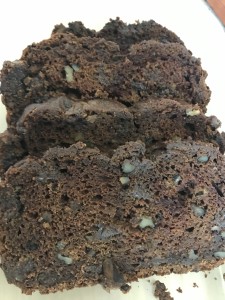Eat Real Food
A Little bit of what you fancy does you good!
My mother always used to say “a little bit of what you fancy does you good,” and I never forgot it. I quote it to people all the time, to my children and always prefaced by ‘my mother used to say…’ My daughter suggested I use it as the name for my next blog post, so here it is!
In the context of health and wellness, I use this statement as a means to explain how important it is to eat “a little bit” of something real, rather than a lot of something chemically altered or synthetic. In this day and age of genetically modified, chemically altered and artificially sweetened, so-called ‘low fat’ food products, it is a very important reminder to those of us who really want to eat clean and healthy, while still shedding a few pounds.
Let’s look at a few common things people tend to eat in place of something real:
Diet soda and artificial sweeteners
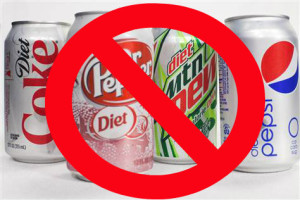
Diet Soda – can you say oxymoron? Of course I’m going to tell you that ANY soda is bad for you. We already know that refined sugar is bad for us, and a glass of soda contains just under 1/4 cup of sugar! But what about diet soda? For some years it has been hailed as something to help with weight loss.
Artificial sweeteners still have an effect on your body by triggering the release of insulin, which causes your body to store fat rather than burn it. It can also cause you to overeat in other areas feeling that you saved calories on a sugar free soda, so can then eat a bit extra (cognitive distortion). The American Beverage Association insists the sweeteners used in diet sodas such as aspartame, sucralose and saccharine, are fully studied and completely safe. However, there are over 900 published studies showing that artificial sweeteners are carcinogenic. For more details follow the link to an article by Dr. Mercola:
Subsequent studies have said that there is no clear connection between artificial sweeteners and cancer, but those were also heavily funded by businesses who use artificial sweeteners in their products…
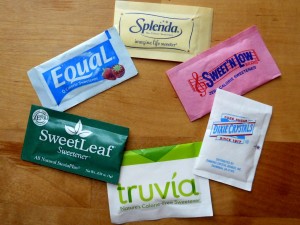 The bottom line here is that it is really best to stay away from soda all together. Look at your consumption of any sugar and/or sugar-like substances, and do your best to eliminate or at least reduce its presence in your diet. The only safe low calorie sugar alternative is Stevia, which comes from a plant. Personally I do not enjoy the flavor of stevia as it is much sweeter than sugar, but if you can take the taste, at least you know you are eating something natural rather than manufactured.
The bottom line here is that it is really best to stay away from soda all together. Look at your consumption of any sugar and/or sugar-like substances, and do your best to eliminate or at least reduce its presence in your diet. The only safe low calorie sugar alternative is Stevia, which comes from a plant. Personally I do not enjoy the flavor of stevia as it is much sweeter than sugar, but if you can take the taste, at least you know you are eating something natural rather than manufactured.
Getting back to the main message: It’s far better to consume ‘a little bit’ of a natural sweetener than lots. But it is better to stay away from chemical sweeteners altogether. Your best options for sweetening agents are honey, molasses, maple syrup, agave, brown sugar and stevia for a low calorie alternative. Glucose has also been shown to be a healthy alternative, although it’s slightly less sweeter than sucrose.
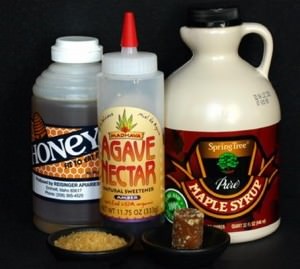
You can’t believe it’s not butter? I can!!!
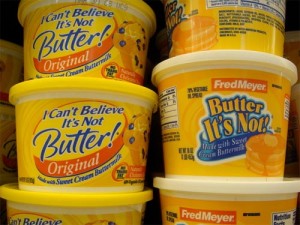 So this is a hot topic: Should we eat butter, with its high fat content, or switch to one of the many low calorie alternatives offered today? When I was young, margarine was the big butter alternative touted to have lower saturated fat and cholesterol. Of course years later we realized that margarine is actually packed with trans-fat, which is way worse for you! But these days there is a new generation of butter alternatives now advertised with no trans-fat BUT they instead contain a myriad of additives and preservatives.
So this is a hot topic: Should we eat butter, with its high fat content, or switch to one of the many low calorie alternatives offered today? When I was young, margarine was the big butter alternative touted to have lower saturated fat and cholesterol. Of course years later we realized that margarine is actually packed with trans-fat, which is way worse for you! But these days there is a new generation of butter alternatives now advertised with no trans-fat BUT they instead contain a myriad of additives and preservatives.
Just because something is low in fat doesn’t mean it’s good for you.
 In fact, these low fat miracle products generally have a bunch of junk in them to make them taste good—extra sugar, chemicals, additives—which in the end are much worse for you than the slightly higher fat content, and prevent your body from losing weight. Skim milk? Might as well call it sugar milk.
In fact, these low fat miracle products generally have a bunch of junk in them to make them taste good—extra sugar, chemicals, additives—which in the end are much worse for you than the slightly higher fat content, and prevent your body from losing weight. Skim milk? Might as well call it sugar milk.
Take it from Dr. Oz: “Don’t drink skim milk, you don’t need to. When you take the fat out of milk, what’s left? Sugar! Skim milk is sugar milk. You want to drink 2% milk, eat 2% yogurt…people who have a little bit of fat in the yogurt lose more weight, because your body is satiated.”
This harkens back to that cognitive distortion thing I mentioned earlier: With ‘low-cal’ products, mentally people think they can eat more, which means more of all that nasty artificial stuff in your system! Higher fat products not only don’t have all the junk added, but also make your body feel more satisfied, meaning you eat less.
Again, this simple rule always holds true: Chemical ingredients are never a good choice!
Butter itself contains only cream and salt, and is packed with a bunch of vitamins such as Vitamin A, important for our endocrine system and maintaining good vision as well as other bodily functions. Also vitamins E, K and D, which play a role in maintaining our cardiovascular system. It contains Lecithin which helps our metabolism work properly, and antioxidants which protect our bodies from disease.
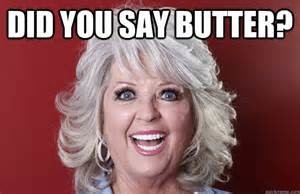
This brings me back to my main point – ‘a little bit of what you fancy does you good‘ … a moderate amount of butter (maybe not Paula Deen amounts!) in our diet is much healthier than the alternatives out there.
Always go for the natural alternative and teach yourself to exercise will power to not overdo it. Part of changing the way you eat is to learn how to enjoy things in moderation, and doing so will help you enjoy those little pleasures immensely more.
Fat free half and half and other fat free products
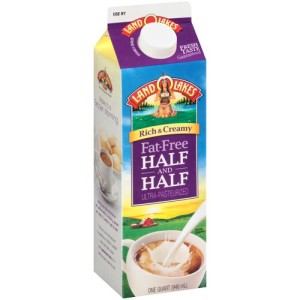 And the oxymorons continue! My first thought would be ‘what’s the point’!!! But I assume people who buy fat free products are under the impression that fat is bad, and this is a way to save fat and calories while still enjoying a ‘fat like’ taste. Well, that ‘fat like’ taste is created by replacing fat with corn syrup and chemical thickeners (carrageenan is most common, and has been linked with cancer in multiple studies) that create the ‘fat like’ flavor and texture. Most fat free products are the same, instead of fat they add corn syrup and chemical additives.
And the oxymorons continue! My first thought would be ‘what’s the point’!!! But I assume people who buy fat free products are under the impression that fat is bad, and this is a way to save fat and calories while still enjoying a ‘fat like’ taste. Well, that ‘fat like’ taste is created by replacing fat with corn syrup and chemical thickeners (carrageenan is most common, and has been linked with cancer in multiple studies) that create the ‘fat like’ flavor and texture. Most fat free products are the same, instead of fat they add corn syrup and chemical additives.
Half and half is so named because it contains equal parts milk and cream—both natural products. It’s far better to enjoy a little bit of half & half rather than a fat free alternative.
What about ‘Low fat’ products?
The recommendation for fat consumption is that we get 20%-35% of our daily calories from fat. That’s about 44 to 77 grams of fat a day assuming you eat 2,000 calories a day. In order for your body to function properly, and your metabolism to work the way that it should, we need enough fat calories. Saturated fat should be kept to a minimum, with mono and polyunsaturated fat making up the majority of daily fat consumption.
Here are a few foods that contain healthty fats:
- Salmon
- Raw nuts (roasting spoils the good oil content)
- Avocado
- Olive, avocado, safflower oils
- Chia seeds
- Flax meal
Low fat foods, much like fat free foods, often contain other ingredients to make up for the lack of fat. The key here is to read the label. Don’t trust companies advertising “all natural; healthy; wholesome”—the fact is that these statements mean nothing, and any company can slap them on their products, regardless of whether the statements are true. If you see that the product contains chemical additives and sugars (especially high fructose corn syrup) to make up for the lack of fat, then it might not be the best choice.
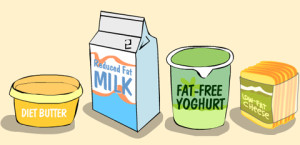
The main take-away messages?
–Real food in moderation is always better than low fat, low calorie, diet alternatives.
–Reading labels is so important. Food manufacturers are always coming up with new chemical ingredients to add to our food to make it last longer, taste better, contain less fat or sugar. A good thing to remember is that as much as they can test these chemicals before using them, it really is only once humans have been consuming them for years that the real effects will come to light.
-It’s so much better to try to avoid additives and preservatives, artificial sweeteners and fat substitutes. Buy natural whole ingredients and either make your own food or choose brands of prepared food that do not contain additives and preservatives.
I try to prepare all my food from scratch so I am in charge of what they contain. I’m also less likely to eat them as much because they take work, effort and time to prepare. On occasion I even like to make my own chocolate from scratch, I maybe eat 2-3 squares of good dark chocolate in a day when I have it available … a square at a time with a nice cup of British tea! I would eat one square of chocolate in place of a dessert after a meal, so I get a little sweet taste without overdoing my sugar intake.
I rest my case, a little bit of what you fancy does you good.
“Moderation. Small helping. Sample a little bit of everything. These are the secrets of happiness and good health”
-Julia Child

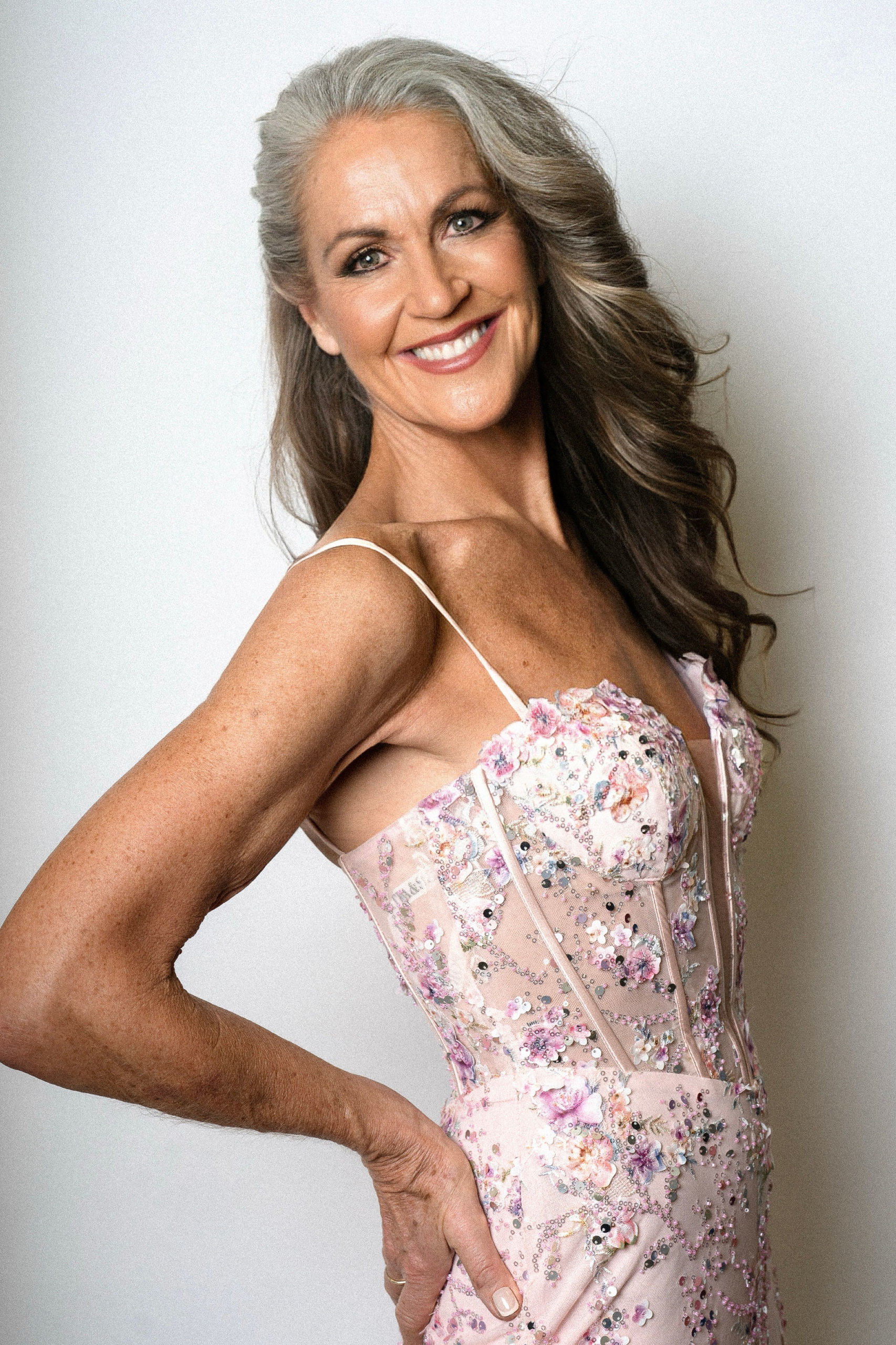
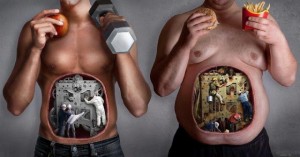

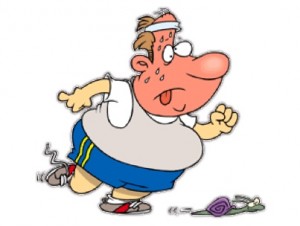 getting more than just our workout in during the week. If a trainer is not possible for you, start by moving more, walking further, parking farther away from places. Take the stairs and not the elevator. Start small and increase gradually, keep a log so you can see the improvement. Check out my workout page for some easy ideas for working out at home.
getting more than just our workout in during the week. If a trainer is not possible for you, start by moving more, walking further, parking farther away from places. Take the stairs and not the elevator. Start small and increase gradually, keep a log so you can see the improvement. Check out my workout page for some easy ideas for working out at home. er. We each need about half our body weight in fluid oz of water daily. This is the best visual image of why
er. We each need about half our body weight in fluid oz of water daily. This is the best visual image of why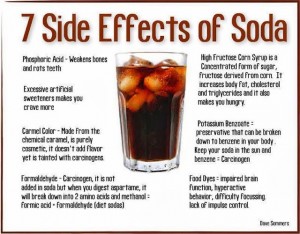
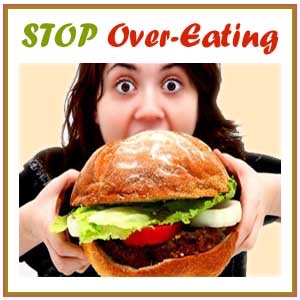 on out of eating, and see it as providing fuel and nutrition for our bodies. Try finding a different habit to comfort you when things don’t go as planned, or a different reward when things go well. This will be a big step in the right direction. Diets can provide a short term solution, but unless you change the way you eat long term, eventually when the diet ends you will resume old habits and gain the weight back again. Slowly purge your pantry of ‘trigger’ foods, those you can’t stop eating, and incorporate healthier choices. For more on this topic go to the ‘Change the way you eat’ page of this site.
on out of eating, and see it as providing fuel and nutrition for our bodies. Try finding a different habit to comfort you when things don’t go as planned, or a different reward when things go well. This will be a big step in the right direction. Diets can provide a short term solution, but unless you change the way you eat long term, eventually when the diet ends you will resume old habits and gain the weight back again. Slowly purge your pantry of ‘trigger’ foods, those you can’t stop eating, and incorporate healthier choices. For more on this topic go to the ‘Change the way you eat’ page of this site.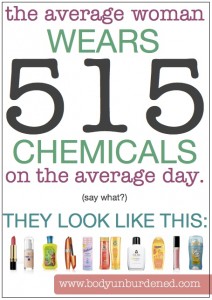
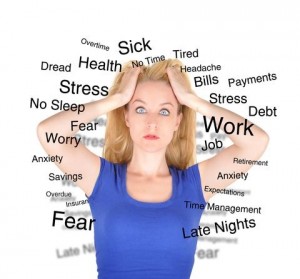
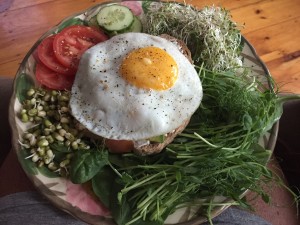
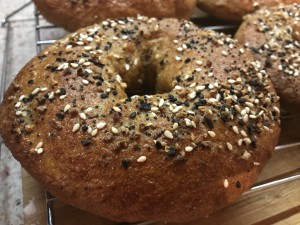
 This is truly a delicious bread that can be souped up to make a great dessert by the addition of whipped cream or if you are going lower fat, add a dollop of vanilla greek yogurt. It’s simple, fairly low fat, and you can decide how much sugar to add depending on your taste and dietary concerns. The walnuts and chocolate chips are optional and how many you put it is also fairly fluid.
This is truly a delicious bread that can be souped up to make a great dessert by the addition of whipped cream or if you are going lower fat, add a dollop of vanilla greek yogurt. It’s simple, fairly low fat, and you can decide how much sugar to add depending on your taste and dietary concerns. The walnuts and chocolate chips are optional and how many you put it is also fairly fluid.